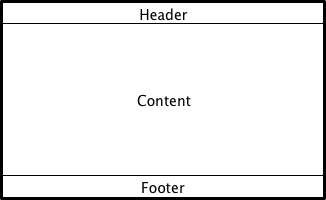Page QML Type
Styled page control with support for a header and footer. More...
| Import Statement: | import QtQuick.Controls |
| Inherits: |
Properties
- footer : Item
- header : Item
- implicitFooterHeight : real
(since QtQuick.Controls 2.5 (Qt 5.12)) - implicitFooterWidth : real
(since QtQuick.Controls 2.5 (Qt 5.12)) - implicitHeaderHeight : real
(since QtQuick.Controls 2.5 (Qt 5.12)) - implicitHeaderWidth : real
(since QtQuick.Controls 2.5 (Qt 5.12)) - title : string
Detailed Description
Page is a container control which makes it convenient to add a header and footer item to a page.

Items declared as children of a Page are:
- automatically parented to the Page's contentItem. Items created dynamically need to be explicitly parented to the contentItem.
- not automatically positioned or resized.
The following example snippet illustrates how to use a page-specific toolbar header and an application-wide tabbar footer.
import QtQuick.Controls import QtQuick.Layouts ApplicationWindow { visible: true StackView { anchors.fill: parent initialItem: Page { header: ToolBar { // ... } ColumnLayout { anchors.fill: parent // ... } } } footer: TabBar { // ... } }
See also ApplicationWindow, Container Controls, and Focus Management in Qt Quick Controls.
Property Documentation
footer : Item |
This property holds the page footer item. The footer item is positioned to the bottom, and resized to the width of the page. The default value is null.
Note: Assigning a ToolBar, TabBar, or DialogButtonBox as a page footer automatically sets the respective ToolBar::position, TabBar::position, or DialogButtonBox::position property to Footer.
See also header and ApplicationWindow::footer.
header : Item |
This property holds the page header item. The header item is positioned to the top, and resized to the width of the page. The default value is null.
Note: Assigning a ToolBar, TabBar, or DialogButtonBox as a page header automatically sets the respective ToolBar::position, TabBar::position, or DialogButtonBox::position property to Header.
See also footer and ApplicationWindow::header.
implicitFooterHeight : real |
This property holds the implicit footer height.
The value is equal to footer && footer.visible ? footer.implicitHeight : 0.
This property was introduced in QtQuick.Controls 2.5 (Qt 5.12).
See also implicitFooterWidth and implicitHeaderHeight.
implicitFooterWidth : real |
This property holds the implicit footer width.
The value is equal to footer && footer.visible ? footer.implicitWidth : 0.
This property was introduced in QtQuick.Controls 2.5 (Qt 5.12).
See also implicitFooterHeight and implicitHeaderWidth.
implicitHeaderHeight : real |
This property holds the implicit header height.
The value is equal to header && header.visible ? header.implicitHeight : 0.
This property was introduced in QtQuick.Controls 2.5 (Qt 5.12).
See also implicitHeaderWidth and implicitFooterHeight.
implicitHeaderWidth : real |
This property holds the implicit header width.
The value is equal to header && header.visible ? header.implicitWidth : 0.
This property was introduced in QtQuick.Controls 2.5 (Qt 5.12).
See also implicitHeaderHeight and implicitFooterWidth.
title : string |
This property holds the page title.
The title is often displayed at the top of a page to give the user context about the page they are viewing.
Page does not render the title itself, but instead relies on the application to do so. For example:
ApplicationWindow { visible: true width: 400 height: 400 header: Label { text: view.currentItem.title horizontalAlignment: Text.AlignHCenter } SwipeView { id: view anchors.fill: parent Page { title: qsTr("Home") } Page { title: qsTr("Discover") } Page { title: qsTr("Activity") } } }